Tag Archives:norwood
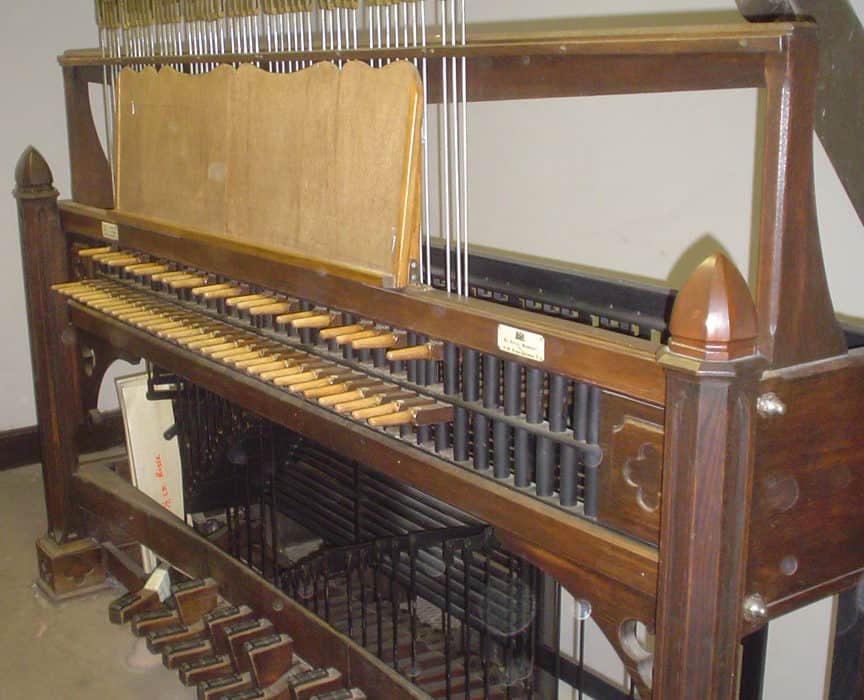
30
MayBells Will Be Ringing
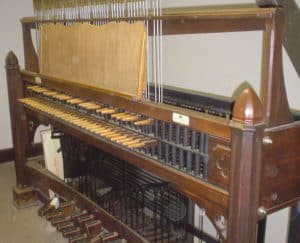
Photo: Lee Leach
One of the many things I didn’t realize about Norwood before moving here is that we have the Walter F. Tilton Memorial Carillon at Town Hall. My undergraduate alma mater also has a carillon which I always enjoyed hearing, so I was excited the first time I heard bells here. I don’t remember the specifics but I suspect I was stopped at the light on Nahatan and Washington and figured the tower was at one of the churches on the Norwood Common since municipal carillons are not very common in the United States. Eventually I discovered it’s in Town Hall and try to listen for at least a few minutes whenever I hear the bells.
Our current Town Carillonneur, Lee Leach, is a frequent library user and at some point the topic of Norwood’s carillon came up in conversation. I told him how much I enjoy hearing the bells and that I am always reminded of my college days. The carillon world is fairly small; there are fewer than a dozen carillons in Massachusetts, so Leach knows the current carillonneur at my alma mater. Not only does she usually participate in the summer concert series, she also brings students to play at Norwood a few times a year. Earlier this winter I was lucky enough to go up in the tower and see/hear some Wellesley College students practicing.
I confess that although I liked hearing the bells on campus I never went up to see the carillon and knew nothing about how the instrument is played. Based on the variety of musical styles I heard, I knew they weren’t ringing the bells by pulling ropes, but beyond that I’m not sure I gave it much thought. For me, seeing the bells and learning how the instrument is played was more interesting than the view. I’ve since done quite a bit of research on the Walter F. Tilton Memorial Carillon, and carillons in general.
A carillon is defined as a musical instrument with at least 23 bells, and is usually in a tower or belfry – anything less than 23 is a chime. Norwood’s carillon has 50 bells as part of the instrument and a 51st bell, which is an old fire bell from Norwood. The carillon is played using a keyboard, or clavier, and pedal board. There are batons rather than keys and the player hits them with the side of his/her fist rather than the finger. Like an organ, there are many more pedals than on a piano. The bells are hung from a frame above the clavier and a series of wires with springs connect to the bell clappers. Striking a baton or pedal makes the wires move the clappers and sound is produced. The clavier can be open to the bell tower or in an enclosed space. Pipe organs are the instrument most similar to a carillon and organ pipes are the only instrument heavier than the largest carillon bells. The Walter F. Tilton Memorial Carillon’s largest, or Bourdon, bell is 71 inches in diameter and weighs 7,840 lbs., it sounds B-flat. Its smallest bell is 6.5 inches in diameter and weighs 11 lbs. Although there is music written for the carillon, many players rework other music for the carillon, including jazz and rock.
Tuned carillons became common during the 1600s in the Benelux countries in Europe, primarily in Belgium and the Netherlands. They were more often found in municipal buildings than in churches. In Singing Bronze: a History of Carillon Music, Luc Rombouts examines why Belgium and the Netherlands were centers of early carillon excellence. He argues that the weaving superiority of the region made it easier for them to create the wire components of the carillon. Reading that made me realize a weaving loom was exactly what the network of wires I’d seen running between the bells and keyboard reminded me of.
The skill of casting tuned bells came close to dying out, but by the turn of the twentieth-century the art had been revived. Before World War I there were fewer than half a dozen carillons in the United States. After the war, many Americans soldiers who heard them for the first time while fighting in Belgium and France felt that carillons were a fitting component of war memorials. Two English foundries: John Taylor and Co., and Gillett & Johnston cornered the American market.
The first municipal carillon in the United States was in Albany, New York’s City Hall. It was cast and installed in 1927 by John Taylor and Co. That company also cast the first carillon in Massachusetts at Our Lady of Good Voyage Church in Gloucester in 1922. The Walter F. Tilton Memorial Carillon is one of three carillons in Massachusetts made by the other significant English foundry, Gillett & Johnston. The Bancroft Memorial Carillon at St. Stephen’s Episcopal Church in Cohasset, dedicated in 1925, was Gillett and Johnston’s third carillon. Norwood’s carillon, dedicated November 11, 1928, was their eighteenth, and Wellesley College’s Galen L. Stone Tower in 1931 was their 34th. More than 30 carillons in less than 10 years made for a busy place – fourteen of those were installed in the United States. England’s Child: the Carillon and the Casting of Big Bells, by Jill Johnston is part biography of Cyril F. Johnston, part corporate history of Gillett & Johnston, and part memoir. Johnston was the child of Cyril F. Johnston and an American nurse who did not learn her father’s identity until after his death.
The Walter F. Tilton Memorial Carillon stopped being played in the late 1970s due to a need for repairs. Once work was begun, it was discovered the entire tower was seriously damaged by water leaks, and repairing the tower and fixing the leaks took precedence. By late 1982, work on the tower itself was nearing completion and the bells could be rehung. In early 1983, the expert hired to evaluate the needed work on the bells discovered that the second and eleventh bells were missing. With all the work that had been in done the tower there was no way to know when or how the bells disappeared. John Taylor, Ltd. of England was the foundry hired to repair and remount the bells. They cast replacements for the two missing bells.
Norwood’s first carillonneur was Kamiel LeFevere, a Belgian who came to the United States to play carillons. He was the first to play at St. Stephen’s in Cohasset and became the carillonneur at Riverside Church in New York City. LeFevere traveled to Norwood to play until 1934. His inaugural performance at the dedication of Norwood’s Town Hall and Carillon was broadcast on radio station WEEI. Roger Walker was the second carillonneur, playing from 1934 until 1972. He lived in Hyde Park, MA so had a much shorter commute for his performances. Martin Gilman played after Walker. George Mahoney, Jr. overlapped with Walker and Gilman. Sally Slade Warner was the carillonneur at St. Stephen’s in Cohasset and also played in Norwood. She managed the summer concert series for many years. Our current carillonneur, Lee Leach heard the Walter F. Tilton Memorial Carillon being played not long after he moved to Norwood in the 1990s. He decided to learn how to play the carillon and has been playing here since 1996. Before Leach, George Mahoney, Jr. was the only Norwood resident to play the Norwood carillon. Leach and Assistant Town Manager Bernie Cooper oversee the carillon. It is a volunteer position for Leach who coordinates the summer concert series, holiday performances and other special events, in addition to playing. There is now another Norwood resident and a few other regular players who are all volunteers.
The 2019 Summer Concert Series kicks off on Monday, June 24 at 7 pm and runs weekly until August 12. If Monday nights don’t work for you, Leach often plays during the farmers’ market on Tuesday afternoons. There will also be a concert on July 4th at 3 pm. The tower is generally open for visitors during or after performances for anyone who is curious to see the instrument. The library will be hosting “Meet the Carillonneurs” on Thursday, June 27 at 6:30 pm with Lee Leach and others who play the Walter F. Tilton Memorial Carillon.
If you have a third grader this year, s/he may go up in the carillon on their field trip to Town Hall. For youngsters who haven’t been up to the carillon, Rosie Meets the Carillon, by Kerri Lu is a story about a little girl whose grandmother plays.
Victoria Andrilenas is a Part-time Adult Services Librarian at the Morrill Memorial Library. Look for her article in the May 30, 2019 issue of the Norwood Transcript.

9
NovNorwood: A Home Town
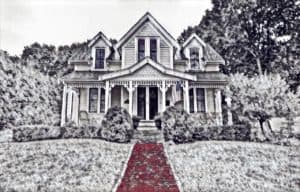 When we moved to Norwood in 2012, I was excited about owning a historic home that was within walking distance to both my work at the library and the town’s center. I wondered how many families had placed their hands on the sturdy wooden banister leading from the second floor. I imagined other women lovingly serving meals for family and guests in the spacious dining room. I was curious about the children and adults who might have peeked out the windows to watch passersby or wait for Halloween trick-or-treaters to knock on the distinctive double doors.
When we moved to Norwood in 2012, I was excited about owning a historic home that was within walking distance to both my work at the library and the town’s center. I wondered how many families had placed their hands on the sturdy wooden banister leading from the second floor. I imagined other women lovingly serving meals for family and guests in the spacious dining room. I was curious about the children and adults who might have peeked out the windows to watch passersby or wait for Halloween trick-or-treaters to knock on the distinctive double doors.
I wished there were photographs hidden in far reaches under the eaves of the deep closets, but there were not.
Working as a librarian certainly has its benefits because I knew just where to look to locate a bit of the house’s history and inhabitants. All of this information can be accessed by anyone who visits Norwood’s history collection in the Cushing Reading Room. Both the Annual Town Reports (now digitally available through the Minuteman Library Network catalog) and Norwood Street Lists are there for anyone to use to research.
Included on those history shelves (while under lock and key, the Adult Information Services librarians will be happy to help unlock them) are two volumes – Norwood: A Home Town. They are rich in architectural detail and structural information that was compiled by both the Norwood Historical Commission and the Massachusetts Historical Commission in the last two decades of the 20th Century. Hundreds of Norwood’s homes are listed by street address; pages that begin with Atwood Avenue and end with Winter Street. Most of the historical descriptions of the hundreds of homes were written by researcher Edward Gordon.
Norwood: A Home Town begins with details of the Town of Norwood’s districts and commercial buildings. Norwood Center, or “the hook,” the F. Holland Day House, the Winslow Brothers tannery complex are all described and illustrated. The town’s amazing presses, among them the Norwood Press and the Plimpton Press, are included. Of particular interest to me are the pages devoted to George H. Morrill & Co. Printing Ink Works. It was George Morrill who built Norwood’s library with his own funds, in memory of his daughter. Like Carnegie of the same era, Morrill shared his wealth and handed over the keys to the library to the town in 1898.
Morrill eventually moved his ink company out of Norwood and consolidated with four other ink companies. In 1945 the Geo. H Morrill Company Division of General Printing Ink Corp was renamed Sun Chemical Corporation.
In 2012, when I decided to research my new home on Prospect Street, I went to the Norwood: A Home Town and the Norwood Street Lists. 305 Prospect Street is listed merely as the Samuel Page House, named for its first owner. It was built in either the 1870s or 1880s on land purchased from the Fairbanks family. On a late 19th century map of Norwood (that can be found in the library’s map drawers), everything north of Prospect Street from Winter to Nahatan streets was illustrated as woods or farmland. This was truly the edge of Norwood’s town center just south of Westwood.
In 1989 the home included a barn in the rear which was removed sometime in the late 20th century. The actual date the house was built is unknown; there was a residence there in 1876, and Samuel Page was listed in the town’s Street Listing as residing there in 1880. However, there is a period when he was listed as living at 276 Prospect Street between 1897 and 1900. Whether mistakes were made, or Samuel moved out to rebuild his home after a fire destroyed the original is unknown.
The architectural character of the house, however, was of the 1880s and today might be thought of as hybrid, encompassing the Stick, Victorian and Queen Anne styles. What we might call Gingerbread is a particular characteristic with overlapping multiple-sided shingles and pretty trim. Perhaps Samuel built it over the years, finally inhabiting it with a family in 1900.
From the Town of Norwood’s Street Listings early in the 20th century, Lillian Page is listed as the resident of the house between 1908 and 1922. She is presumably Samuel’s daughter, or perhaps a younger wife. She left the home in 1922.
The 37-year period between 1922 and 1959 saw three families in the home, two of them staying only ten or eleven years each. Twenty-seven-year-old Joseph Youlden and his wife Dorothy, five years younger, might have raised their family there. Children under twenty were not listed in the Street Listings. In 1939 thirty-five-year-old Harry Fraser (a landscape architect) and his wife, Helen moved to Prospect Street from Highland Street – from perhaps a much smaller home that is not listed in the Norwood: A Home Town. In 1949 Raymond and Grace Rafuse, both in their fifties, moved from a house across from the Highland Cemetery on Winter Street. Their two working daughters lived with them, Gladys was born in 1920, and Jean was born in 1925.
It was in 1959 that John Payne moved into the home from Dedham and lived there for 41 years with his wife, Jeannette. For a time, a young nurse named Mary Orphan lived with them. There were several anecdotal stories about the Paynes – there were teenage daughters who had parties there. Jeannette died in 1988, and the home then lost its attentive care. It was in particularly neglected shape when a young hockey-minded couple from the area, Timothy and Anne Lovell, purchased it in 2001. They restored much of its charm and character, added a long brick walkway to the front porch, and renovated the kitchen and baths. They lived there with their four young children until 2012.
We loved living in such a sweet and gentle home in one of Norwood’s lovely neighborhoods and will miss much about the house, particularly its front and side porches. We watched lightning storms travel south as we rocked on our glider on the left front porch, hidden by the azaleas and Boxwood bushes. We admired joggers and dog walkers who took in their exercise every morning and night. From the private side porch off the kitchen, we sipped morning coffee, our feet propped on the white railing.
Approaching cars shown lights in our dining room windows as they turned the corner from Cottage Street heading east towards Dedham. Through open windows, we heard the sirens of Norwood’s most exceptional fire and police departments and listened to the faint sounds of concerts on the Town Common. In the wee morning hours near 4 am, we were sometimes sleepily awakened by the sound of the commuter rail’s train whistle.
Lucky for us, we will commute from our home on the South Coast to our jobs in Norwood, a Town in which we truly feel “at home.” If you want to know more about the houses in Norwood, visit the library’s historical collection in the Cushing Reading Room.
Charlotte Canelli is the Director of the Morrill Memorial Library in Norwood, Massachusetts. Read Charlotte’s column in the November 8, 2018 edition of the Norwood Transcript and Bulletin.
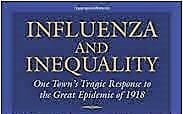
14
SepA Century Later – Norwood’s Experience in the 1918 Flu Epidemic
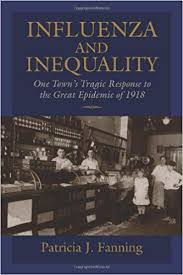 The Black Death (or Bubonic or Great Plague) was a four-year epidemic that affected 30-60% of the European population. It was critical to the history of the Middle Ages that we studied. The Great Plague is believed to have begun in Central Asia in the early 1330s where it was carried by rats on ships across and throughout the Mediterranean and Europe. It is believed to have killed up to 200 million people across Europe from 1347-1351 and it may have taken 200 years before the world’s population recovered from the loss of life from the epidemic.
The Black Death (or Bubonic or Great Plague) was a four-year epidemic that affected 30-60% of the European population. It was critical to the history of the Middle Ages that we studied. The Great Plague is believed to have begun in Central Asia in the early 1330s where it was carried by rats on ships across and throughout the Mediterranean and Europe. It is believed to have killed up to 200 million people across Europe from 1347-1351 and it may have taken 200 years before the world’s population recovered from the loss of life from the epidemic.
Many of us remember studying the Middle Ages and its Black Death in school. What we might not have learned was that there were many plagues throughout history.
The Bubonic Plague reappeared several times again in Europe, but not with the same devastating power. Pulitzer Prize author Geraldine Brooks wrote a startling and heartbreaking account of towns in England suffering from a 1600s plague and its shattering impacts on families, government, and society. The 2001 historical novel, Year of Wonders, is currently in film production.
In 1918, at the end of The Great War (or WWI) the Spanish Flu, or the Pandemic of 1918-1919, affected one-fifth of the entire world’s population. It killed more people than those who had died in the Great War. Somewhere around 20 million to 40 million people died in twelve months.
I don’t remember studying or hearing much about the Spanish Flu in America. Many of my aunts and uncles were alive in 1918 – and certainly my grandparents – and I heard no stories from them during their lifetimes. However, 28% of Americans were affected by the Spanish Flu and more than 675,000 died. The epidemic affected Americans between 20 and 40 years of old the most severely – more than 10 times the soldiers set to return to America from Europe died of the flu than who had died in the war.
Liz Reed, Adult Services Librarian here at our library in Norwood was recently awarded a Massachusetts Humanities Discussion grant to present Norwood’s experience with the pandemic of 1918. A Century Later: Norwood’s Experience in the Great Flu Epidemic of 1918 is a series of 8 events planned throughout the month of October. Several Town of Norwood departments have partnered with the Morrill Memorial Library – the Norwood Public Health Department, the Norwood Highland Cemetery, and the Norwood Senior Center. Also collaborating is the Norwood Historical Society.
Two of the events will focus on books. One was written by Norwood historian and retired professor, Patricia Fanning. Patti Fanning’s book, Influenza and Inequality, began as an academic study of the Town of Norwood’s response to the 1918 epidemic was published in 1910 by the University of Massachusetts. The Historical Journal of Massachusetts writes that “Historians once thought that the pandemic struck down its victims irrespective of class or ethnicity. [Patricia] Fanning dispels this error, demonstrating that immigrants and the poor died in Norwood in disproportionate numbers.”
The other book being discussed during the series, Pale Horse, Pale Rider is a novella by Katherine Anne Porter published in 1939. Porter’s novella depicts the tragedy and suffering in a story of Miranda, a newspaper woman in Denver, Colorado who is tended while sick and delirious from the influenza epidemic of 1918. Adam, a soldier who is also stricken with the flu dies while Miranda is recovering.
The series will begin with a discussion of Porter’s novella at the Day House in Norwood on Tuesday, October 2. Dr. Cashman Kerr Prince, library trustee and member of the Historical Society, will lead the event beginning at 6:30 pm.
On October 10 at 6:30 pm, Dr. Al DeMaria will present A History of Firsts: Public Health in the Commonwealth of Massachusetts. Dr. DeMaria is Medical Director of the Bureau of Infectious Disease and Laboratory Sciences and State Epidemiologist in the Massachusetts Department of Public Health. He is also President of the Massachusetts Infectious Diseases Society. He will lead us on a fascinating journey through the history of public health and disease in Massachusetts.
On Saturday, October 13 between 9 and 11 am, a flu vaccine clinic will be held at the Norwood Senior center. It is open to all residents 14 years or older and the Public Health Department requests that everyone who requests a vaccine bring their health insurance information.
On Monday, October 15 at 6:30 pm at the library, noted historian and author Anthony Sammarco will present Boston 1918: The Spanish Flu. He will lead participants on an exploration of Boston during World War I, the disease that decimated the world, and Boston’s response to the flu epidemic.
On Monday, October 22 at 6:30 pm at the library, author Patti Fanning and library director Charlotte Canelli will lead a discussion of Influenza and Inequality. Ms. Fanning will discuss Norwood’s tragic response to the pandemic that resulted in deaths that occurred in the pockets of Norwood where both the poor and immigrants lived in conditions that both spread the flu and did little to help its victims.
On Saturday, October 27 at 3:00 pm, Patti Fanning will lead a walking tour of Highland Cemetery, the resting place of many Norwood flu epidemic victims. The walk literally illustrates history as the steps of the grieving families and overwhelmed town officials will be retraced. There will be simultaneous flu vaccine clinic on the cemetery grounds courtesy of the Norwood Public Health Department. (Rain date is Sunday, October 28.)
This month-long series will end with the last program on October 29 at 6:30 pm at the library. Influenza 1918, a short documentary film produced by WGBH Boston will be shown. A discussion will follow, tying together personal stories with the historical events.
Registration for these events is available by calling or visiting the library or emailing norprograms@minlib.net. Books for both discussion groups will be available upon registration.
Once the program has ended, book clubs may request the Book Club Kit of Patti Fanning’s book, Influenza and Inequality from the Minuteman Library catalog. Please call the library for more information. We hope you will join us for this very historical, very relevant, very important series!
Charlotte Canelli is the Director of the Morrill Memorial Library in Norwood, Massachusetts. Read Charlotte’s column in the September 13, 2018 edition of the Norwood Transcript and Bulletin.
